Introduction
Alzheimer’s disease is a progressive neurological disease of the brain leading to the irreversible loss of neurons and the loss of intellectual abilities, including memory and reasoning, which become severe enough to impede social or occupational functioning. Alzheimer’s disease is also known as simply Alzheimer’s, and Senile Dementia of the Alzheimer Type (SDAT). Patients with Alzheimer’s have a deficiency in the levels of some vital brain chemicals which are involved with the transmission of messages in the brain – neurotransmitters. Alzheimer’s disease is the most common form of dementia. There is no current cure for Alzheimer’s, although there are ways of slowing down its advance and helping patients with some of the symptoms. Alzheimer’s is also a terminal disease – it is incurable and causes death. Aloysius Alzheimer was a German neuropathologist and psychiatrist. He is credited with identifying the first published case of “presenile dementia” in 1906, which Kraepelin later identified as Alzheimer’s disease – naming it after his colleague. Alzheimer’s disease accounts for 50 to 80 percent of dementia cases1.
Alzheimer’s is the most common form of dementia in human population. Although affecting primarily older age groups (60+), symptoms can start appearing a bit earlier and are often ignored as age-related changes or stress disorders. This disease has been estimated to affect anywhere between 25 to 50 million people worldwide, though its prevalence is believed to be increasing due to changing lifestyle habits and exposure to environmental hazards. We are finding increased numbers of Alzheimer’s cases in India like out of per 1,000 population almost 33 people are affected. The true prevalence of these diseases in our country has been difficult to estimate, though some studies suggest that there are about 37 lakh Indians affected by Alzheimer’s at present2. It is estimated that the number of people suffering from Alzheimer’s will double by 2030.Therefore, it is indeed a source of concern, and a concerted effort by government and private healthcare providers is required to create awareness and generate facilities for early and timely diagnosis, treatment and rehabilitation of these cases. Around 50-75% proportion of dementia cases in India are because of Alzheimer’s disease3.
Few quantitative studies have been carried out in the area of Alzheimer’s disease research. Mache et al4 evaluates the scientific efforts in Alzheimer disease by analyzing 50030 publications from 1985 to 2008. Large scale data analysis, density equalizing algorithms and scientific methods were used to evaluate the quantity and quality of research achievements in this area. Sorenson5 analyzed the role of Alzheimer’s disease (AD) within neurosciences and presents the summary of the various research foci within the AD scientific community. It identifies the top 100 AD researchers and assesses their productivity and scientific impact. There are no specific studies available in the literature dealing with scientometric analysis of publications in the area of Alzheimer’s disease research in country context. However, the various Indian scholars and the present authors have carried out similar studies in Indian context on other diseases such as diabetes6, tuberculosis7, malaria8, asthma9 and typhoid10
Objectives
The main objective of this study is to analyze the research performance of India in Alzheimer’s disease research in national context, as reflected in its publications output during 2002-11. In particular, the study focuses on the following objectives: (i) To study the Indian research output, its growth, rank and global publications share and impact, (ii) To study the patterns of international collaboration and major collaborative partners, (iii) To study the publications productivity and impact of leading institutions and authors of India; and (iv) To study the media of communication.
Methodology and Database Used
This study is based on the Indian publication data in Alzheimer’s disease research retrieved from the Scopus Citation database [http://www.scopus.com/search/] for the 10 years (2002-2011). The string used to retrieve the data in Alzheimer’s disease research was developed using the Alzheimer* disease keyword in title, abstract and keywords and India in affiliation field becomes finally our main string. Similar strings were used to generate publications output data on top 20 countries. For citations data, three years, two year, one year and zero year citations window has been used for computing average citations per paper in Alzheimer’s disease research during 2002-08, 2009, 2010 and 2011 respectively. ( e.g. for the papers published during 2002, the total citations received by these papers during three years from 2002-2005 has been derived from the database. Similarly for papers published during 2003, the total citations received by these papers during three years from 2003-2006 has been derived from the database and so on). For searching and calculating the total international collaborative papers, a separate search strategy, which combines India’s collaboration with 200 major countries, was prepared and this string was combined with the main string to generate India’s total international collaborative output. For analyzing institutional, author and journals output, the separate search strategies for generating institutional, author and journal outputs were developed, which later combined with the main string to generate the desired output.
Analysis
Global Publication Share & Rank
The global publication share of the top 20 most productive countries in Alzheimer’s disease research varies from 0.98% to 37.21% during 2002-11. The United States tops the list, with a share of 37.21% during 2002-11. The United Kingdom ranks second (with 8.74% share), followed by Germany, Italy, Japan, China, France and Canada (with publications share ranging from 4.46% to 6.74%. Spain, Australia, Sweden, Netherlands and Sweden ranks at 9th to 13th positions (their global publications share ranging from 2.09% to 3.62%). The countries that fall between 14h and 20th positions are South Korea, Belgium, India, Brazil, Israel, Austria and Poland with their global publications share ranging from 0.98% to 1.70% (Table 1).
The developed countries showing increase in their publications share are Italy by 2.09%, followed by Spain (1.60%), Canada (1.02%), Australia (0.85%), France (0.56%), Netherlands (0.52%), Poland (0.47%), Sweden (0.37%), Germany (0.36%), Belgium (0.21%), UK (0.11%) and Switzerland (0.05%) from the year 2002 to the year 2011. In contrast, the developed countries showing decrease in their publications share during the same period are Japan by 1.87%, followed by USA (0.93%) and Austria (0.36%). All developing countries except Israel, on the other hand, have shown rise in their publications share in Alzheimer’s disease research: China by 5.04%, followed by India (1.97%), South Korea (1.74%) and Brazil (1.11%) from the year 2002 to the year 2011 (Table 1).
Table 1. Publications Output, Share and Rank of Top 20 Countries in Alzheimer’s Disease Research, 2002-11
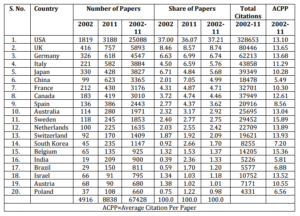
India ranks at 16th position among the top 20 most productive countries in Alzheimer’s disease research with its global publications share of 1.33% during 2002-11. China, South Korea and Brazil ranked at 6th, 14th and 17h positions, with global publications share of 4.99%, 1.70% and 1.20%, respectively during 2002-11. India’s global publications share increased from 0.39% to 2.36% from the year 2002 to the year 2011. China, South Korea and Brazil’s global publications share increased from 2.01% to 7.05%, 0.92% to 2.66% and 0.59% to 1.70% from the year 2002 to the year 2011 (Table 1).
Considering the quality of papers published by these productive countries in terms of average citation per paper, which varies from 5.49 to 15.89 during 2002-11. The highest citation impact is registered by Sweden with 15.89 citations per paper, followed by Belgium (15.36), Switzerland (13.93), Netherlands (13.89), Germany (13.68), U.K (13.65), Israel (13.52), USA (13.10) and Australia (13.04). Canada, Italy, Austria, France and Japan scored the impact varying between 10.28 to 12.61 citations per paper. Spain, South Korea, Brazil, Poland, India and China achieved scored the impact varying between 5.49 to 8.56 citations per paper. (Table 1)
India’s Publication Output in Alzheimer’s Disease Research
India’s cumulative publication output in Alzheimer’s disease research consisted of 900 papers during 2002-11, with an average number of 90.00 papers per year and an annual average growth rate of 31.92%. The cumulative publications output of India in Alzheimer’s disease research increased from 226 papers during 2002-06 to 674 papers during 2007-11, witnessing a growth of 198.23% (Table 2).
In terms of impact and citation quality, the average citation per paper registered by India’s publication output was 5.81 during 2002-11. The average citation per paper of cumulative publications in Alzheimer’s disease research of India has decreased from 8.85 during 2002-06 to 4.79 during 2007-11 (Table 2).
Table 2. Growth & International Collaboration Share of Indian Alzheimer’s Disease Publications, 2002-11
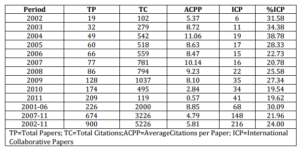
International Collaboration in India’s Publication Output
The total number of Indian papers involving international collaboration during 2002-11 is 216, accounting for 24.00% share in the cumulative publications output of India in Alzheimer’s disease research. India witnessed a decrease in the share of its international collaborative papers from 30.09% during 2002-06 to 21.96% during 2007-11 in Alzheimer’s disease research (Table 2)
Among the major international collaborators (44 countries), 16 countries have published 6 or more collaborative papers with India during 2002-11 (Table 3). United States was the major collaborating partner of India during 2002-11 accounting for 52.31% of collaborative publications, followed by United Kingdom (with 16.20% share) and Italy (7.41% share). Japan, Malaysia, China, Dominican Republic, Australia and Canada accounted for publication share varying from 3.24% to 4.63%. Venezuela, Peru, Cuba, South Korea, Germany, Mexico and Netherlands accounted for publication share of 2.78% each during 2002-2011.
Of these top 16 international collaborative countries, India’s collaborative linkages has decreased with three countries with largest decrease in USA by 11.64%, followed by Netherlands (6.67%), U.K (4.26%), and Dominican Republic (0.36%) from 2002-06 to 2007-11. India’s collaborative linkages have increased with 12 countries with maximum increase of 6.76% with Malaysia, followed by Italy (4.37%), Germany (4.05%), Canada (2.58%), Venezuela, Peru, Cuba, South Korea and Mexico (1.91% each), Australia (1.11%), Japan and China (0.32%) from 2002-06 to 2007-11 (Table 3).
Table 3. Contribution of Major Collaborative Partners of India in Alzheimer’s Disease Research during 2002-11
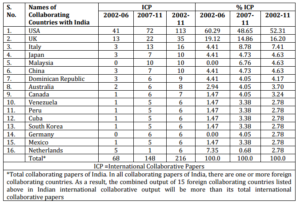
Indian Alzheimer’s disease Research Output in Context of Different Subjects
India’s publication output in Alzheimer’s disease research during 2002-11 has been published in context of 7 subjects (as reflected in database classification based on journal subject content), with highest publications output coming from Pharmacology, toxicology & pharmaceutics with 340 papers and 38.78% publications share, followed by Medicine (330 papers and 37.67% publications share), Biochemistry, genetics & molecular biology (298 papers and 34.11% publications share), Neurosciences (163 papers and 19.11% publications share), Chemistry (94 papers and 11.44% publications share), Psychiatry and psychology (35 papers and 4.89% publications share), Agricultural & biological sciences (33 papers and 4.67% publications share) and Immunology and microbiology (11 papers and 2.22% publications share). On analyzing the quality and citation impact of Alzheimer’s disease research under different subjects, it was found that Agricultural & biological sciences had scored the highest impact of 9.67 citations per paper, followed by Immunology and microbiology (9.00 citations per paper), Psychiatry and psychology (7.84 citations per paper), Neurosciences (7.24 citations per paper), Biochemistry, genetics & molecular biology (7.07 citations per paper), Chemistry (6.97 citations per paper), Medicine (5.99 citations per paper) and Pharmacology, toxicology & pharmaceutics (5.46 citations per paper) (Table 4)
Table 4. Subject-Wise Break-up of Indian Alzheimer’s Disease Publications during 2002-11
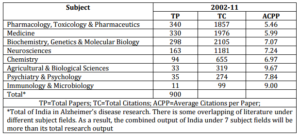
Research Profile of Most Productive Indian Institutions in Alzheimer’s Disease Research
The top 20 most productive Indian institutions involved in Alzheimer’s disease research have published 10 or more papers each during 2002-11. The publication profile of these 20 Indian institutions along with their research output, citations received and h-index values are presented in Table 5. These 20 Indian institutions account for 41.00% share (369 papers) in the cumulative publications output of India with an average output per institution of 18.45. Seven Indian institutions have registered higher publications share than the group average. These are All India Institute of Medical Sciences, New Delhi with 38 papers during 2002-11, followed by Panjab University, University Institute of Pharmaceutical Sciences, Chandigarh (35 papers), National Institute of Mental Health & Neurosciences, Bangalore (33 papers), Central Food Technological Research Institute, Mysore (26 papers), Guru Jamleshwar University of Science & Technology, Hisar (23 papers), National Institute of Pharmaceutical Education & Research, Mohali (21 papers) and Central Leather Research Institute, Chennai (19 papers). The average citation per paper registered by the total papers of these 20 Indian institutions is 5.82 on a three year citation window. Ten Indian institutions have registered comparative higher impact than the group average. The highest impact of 12.14 citations per paper was scored by the National Institute of Pharmaceutical Education & Research, Mohali, followed by Jadavpur University, Kolkata (9.00 citations per paper), National Brain Research Centre, Manesar, Gurgaon (8.88 citations per paper), Aligarh Muslim University (8.70 citations per paper), Central Food Technological Research Institute, Mysore (7.73 citations per paper), Central Drug Research Institute, Lucknow (6.67 citations per paper), Indian Institute of Science, Bangalore (6.64 citations per paper), National Institute of Mental Health & Neurosciences, Bangalore (6.45 citations per paper), Jawaharlal Nehru University, New Delhi (6.42 citations per paper) and Panjab University, University Institute of Pharmaceutical Sciences, Chandigarh (6.40). Measuring the performance of these institutions on the basis of h- index, nine institutions have achieved a higher h-index value than the group average of 7.95. These are Panjab University, University Institute of Pharmaceutical Sciences, Chandigarh with h-index of 26, followed by All India Institute of Medical Sciences, New Delhi (12), Central Food Technological Research Institute, Mysore, Guru Jambeshwar University of Science & Technology, Hissar and National Institute of Pharmaceutical Education & Research, Mohali (10 each), National Institute of Mental Health & Neurosciences, Bangalore and National Brain Research Centre, Manesar, Gurgaon (9 each), Central Leather Research Institute, Chennai and Mysore Medical College (8 each) (Table 5).
Table 5. Productivity & Impact of Top Twenty Indian Institutions in Alzheimer’s Disease Research, 2002-11
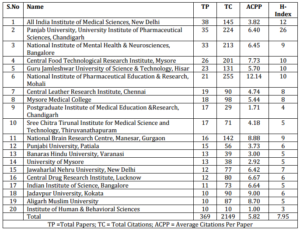
Contributions and Impact of Most Productive Authors in Indian Alzheimer’s Disease Research
Fifteen authors have been identified as productive authors who have published 7 or more papers in Alzheimer’s disease research. These 15 authors together contributed 173 papers with an average of 11.53 papers per author and account for 19.22% of publications share in cumulative publication output of India during 2002-11. Five authors have published higher number of papers than the group average (11.53). These are: M. Parle with 24 papers, followed by K. Kumar (16 papers), K.S.J. Rao and R. Jayakumar (15 papers each) and H. Joshi (13 papers). Considering the quality/impact of papers, these productive authors have received a total of 1214 citations for 173 papers with an average of 7.01 citations per paper. Six authors have registered higher impact than the average. These are: S.K. Maji with ACPP of 20.14, followed by M.L. Hedge (12.25), K.S.Jacob (11.63) S.K. Kulkarni (8.80), P.K. Mandal (7.60), K.S.J. Rao (7.20) and K.S. Shaji (7.13). Measuring the performance of these authors on the basis of h- index, six authors have achieved a higher h-index value than the group average of 6.13. These are M. Parle with h-index of 10, K.S.J. Rao (9), S.K. Kulkarni and K. Kumar (8 each), M.L. Hedge and R. Jayakumar (7 each). (Table 6)
Table 6. Productivity & Impact of Fifteen Most Productive Indian Authors in Alzheimer’s Disease Research, 2002-11
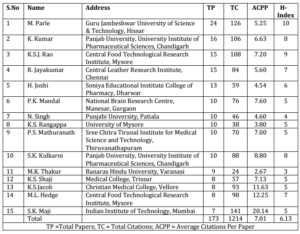
Patterns of Research Communication
The 15 most productive Indian and foreign journals publishing Indian research papers together contributed 165 papers in Alzheimer’s disease research, which accounts for 18.33% of the total output of India during 2002-11. The cumulative publications share of these 15 most productive journals showed a decrease in India’s publications output from 18.58% during 2002-06 to 18.25% during 2007-11 (Table 7).
Table 7: List of Most Productive Journals Publishing Indian Papers in Alzheimer’s Disease, 2002-11
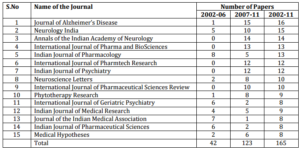
Summary and Discussion
Indian scientists together have published 900 papers in Alzheimer’s disease research during 2002-11. India ranks 16thamong the top 20 countries in Alzheimer’s disease research with a global publications share of 1.33% during 2002-11, which increased from 0.39% in 2002 to 2.36% in 2011. It witnessed an annual average publication growth rate of 31.92% and registered an average of 5.81 citations per paper during 2002-11, which decreased from 8.85 during 2002-06 to 4.79 during 2007-11. International collaboration of India in Alzheimer’s disease research accounts for 24.00% share during 2002-11, which decreased from 30.09% during 2002-06 to 21.96% during 2007-11. USA is India’s major collaborative partner during 2002-11 with a share of 52.31%, followed by United Kingdom (with 16.20% share), Italy (7.41%) etc.
The distribution of Indian Alzheimer’s disease research under different subjects shows that the highest research output (340 papers) coming from Pharmacology, toxicology & pharmaceutics with 38.78% publications share and Agricultural & biological sciences had scored the highest citation impact of 9.67 citations per paper.
The 369 cumulative publications from 15 most productive Indian institutions in Alzheimer’s disease research accounts for 41.00% share in India’s total publications output, registered an average citation impact of 5.82 citations per paper and an average h-index value of 7.95 during 2002-11. The 15 most productive Indian authors in Alzheimer’s disease research together contributed 173 papers and 19.22% publications share, registered an average impact of 7.01 citations per paper and an average h-index of 6.13 per author during 2002-11. The 15 most productive journals publishing Indian research papers in Alzheimer’s disease research together accounts for 18.33% (165 papers) share of the total output of India during 2002-11, which decreased from 18.58% during 2002-06 to 18.25% during 2007-11.
In spite of 37 lakh people suffering from Alzheimer’s disease in India, it had produced only 900 papers during the last ten years from 2002-11. The quality of Indian research output is quiet low compared to all other top 20 countries. There is, therefore, an urgent need to increase both the quantity and quality of research efforts through increased national funding and by enlarging national and international collaborative research efforts in the country. The government must develop a strategy to respond to the growing need for care from early diagnosis to end of life care for Alzheimer’s disease patients. The government should declare Alzheimer’s disease as a national priority and sufficient budget should be provided for its care and research in the Five Year Plans of the Ministry of Health & Family Welfare. There is a need to increase the quantum of research efforts through extra-mural funding of all major Indian science agencies/departments. Education of the general public as well as training of health service providers and social services sector is required for early identification of the disease. Early identification of people involved with Alzheimer’s disease and care training of such people should be made a core and substantial part of the training curriculum for physicians, other medical specialists, nurses, health workers and other non-specialist health workers. Existing Indian government policies and programmes do not adequately address issues and concerns of Alzheimer’s disease patients; there is a need to be comprehensive and also evolve a strategy. There is a need to relook and review existing policies and laws for elders Alzheimer’s disease patients and develop a new. The National Policy for Older Persons may be amended to include Alzheimer’s disease patients.
References
What Is Alzheimer’s Disease? What Causes Alzheimer’s Disease? 31 Jul 2009.http://www.medicalnewstoday.com/articles/159442.php (Accessed on July 31, 2012).
Publisher
http://www.timescrest.com/life/the-cost-of-ignoring-alzheimers-3496 (Accessed on 6.9.2012).
Publisher
Rao, M. & Agarwal, P. (2012). Advancements in Alzheimer’s and Parkinson’s: Newer Avenues for Older Diseases, June 23, 2012. http://modernmedicare.co.in/articles/cover-story/advancements-in-alzheimers-and-parkinsons-newer-avenues-for-older-
diseases/(AccessedonJuly31,2012).
Publisher
Mache, S., Tropp, S., Vitzthum, K., Kusma, B., Scutaru, C, Quarcoo, D., Klapp, B. F. & Groeneberg, D. A. (2010). “Alzheimer’s Disease — A Scientometric Analysis and Data Acquisition,” Aktuelle Neurologie 37(5) (June 2010) 206-12 (In German).
Publisher – Google Scholar
Sorensen, A. A. (2009). “Alzheimer’s Disease Research: Scientific Productivity and Impact of Top 100 Investigators in the Field,” Journal of Alzheimer’s disease 16, 451-65.
Publisher
Bala, A. & Gupta, B. M. (2012). “Diabetes Research in India, China and Brazil: A Comparative Quantitative Study, 2000-09,” Journal of Advances in Library and Information Science 3:110.
Publisher – Google Scholar
Gupta, B. M. & Bala, A. (2011). “Mapping of Tuberculosis Research in India: A Scientometric Analysis of Publications Output during 1998-2009,” COLLNET Journal of Scientometrics & Information Management 5(1) (June 2011) 33-51.
Publisher – Google Scholar
Gupta, B. M. & Bala, A. (2011). “A bibliometric Analysis of Malaria Research in India during 1998-2008,” Journal of Vector Borne Diseases 48 (September 2011) 163-170.
Publisher – Google Scholar
Gupta, B. M. & Bala, A. (2011). “Mapping of Asthma Research in India: A Scientometric Analysis of Publications Output during 1999-2008,” Lung India 28(4) (October-December 2011) 239-46.
Publisher – Google Scholar
Gupta, B. M., Bala, A., Baidwan, K., Chadhha, N. & Cheema, H. S. (2011). “Mapping of Typhoid Research in India: A Scientometric Analysis of Publications Output in 2000-2009,” Chinese Librarianship: An International Electronic Journal,2011, 31. URL: http://www.iclc.us/cliej/cl31GBBCC.pdf
Publisher









